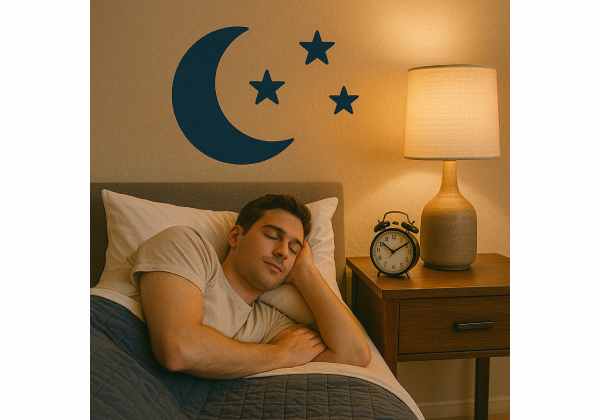
Sleep shapes your appetite, mood, and daily energy—the exact levers that make weight loss doable or draining. When sleep runs short, hunger rises, cravings sharpen, and the will to prepare food or move drops. When sleep is consistent, meals feel easier and movement fits naturally into the day. This guide explains the hours most adults need, why sleep changes fat loss, and how to build a schedule that survives busy weeks, travel, or kids. You will leave with a practical sleep plan, food and caffeine timings that help, and clear checkpoints to track progress. For a broader framework that connects sleep with habits and stress, see our concise overview of sleep and habit fundamentals.
Table of Contents
- Sleep for weight loss basics
- How many hours you need
- Build your sleep plan
- Food, drink and sleep
- Mistakes and troubleshooting
- Who needs extra care
- Evidence and results timeline
- Frequently asked questions
Sleep for weight loss basics
Sleep is the environment where your plan either gets easier or harder. After one short night, appetite signals shift: ghrelin (the “eat” cue) nudges up, leptin (the “enough” cue) drifts down, and your brain favors quick energy. That is why sugar and ultra-processed snack foods feel louder when you are tired. Add decision fatigue and you get more unplanned bites and fewer steps—small drifts that erase a week’s careful work.
What better sleep changes:
- Calmer appetite. You feel “even” between meals, not pulled toward grazing.
- Steadier energy. Walks, lifts, and meal prep feel doable even on busy days.
- Fewer evening raids. Cravings fade when your brain is less reward-seeking from fatigue.
- Improved insulin sensitivity. Your body handles carbohydrates more predictably, which helps with both performance and satiety.
How many hours matter—and why averages beat perfect days. Weight change responds to weekly behavior, not a single night. If your average sleep climbs into a healthy zone, your appetite and energy stabilize even when a day or two runs short. That is the goal: repeatable nights that hold during real life.
A simple operating system:
- Pick a stable sleep window. Most adults do well with a consistent 7–9 hours in bed.
- Place your biggest balanced meal earlier in your waking period so late hunger softens.
- Use light as a steering wheel. Bright light after waking, dimmer light an hour before bed.
- Time caffeine on purpose. Enjoy it early; stop 8–10 hours before lights-out.
- Track one metric you can keep. Weekly sleep average, bedtime consistency, or number of nights ≥7 hours.
Why this belongs in a weight plan. Sleep is not an add-on; it is a multiplier. If you are building a sustainable nutrition and movement routine, pair these sleep steps with clear targets and pacing like our safe weight loss steps. When sleep supports the plan, small caloric nudges and modest activity changes suddenly work.
Bottom line: You do not need perfect sleep to lose weight. You need consistent, good-enough sleep most nights so your choices are the easy ones, not the uphill ones.
How many hours you need
Aim for 7–9 hours in bed, most nights, with an average ≥7 hours of actual sleep. That range covers the vast majority of healthy adults. Some feel great near 7–7.5 hours; others do best near 8.5–9. Your right number is the one that gives you stable energy, calm appetite, and easy focus without relying on afternoon caffeine.
How to find your number in two weeks:
- Set a fixed wake time that fits work and family. Protect it seven days a week.
- Count back 8 hours to set lights-out. Keep that time within a 30-minute window nightly.
- Track how you feel by midday (energy, focus) and by evening (cravings, irritability).
- Nudge bedtime earlier by 15 minutes if you are dragging or craving sugar at night.
- Hold the new bedtime for three nights before changing again.
Markers you are sleeping enough:
- You wake near your alarm or before it.
- You can focus without chasing coffee at 3 p.m.
- Evening cravings shrink, and you feel “done” after dinner.
- Training or walks feel normal rather than forced.
Markers you need more:
- You snack more after dinner, “just because.”
- You feel foggy or wired-tired during the day.
- You rely on late caffeine to push through.
- Weekend sleep runs much later than weekdays (sleep debt payback).
What about athletes or heavy training? Many active people benefit from the upper half of the range (8–9 hours), especially when volume or intensity increases. If you are lifting hard or chasing steps for a cut, sleep becomes the recovery window that keeps hunger manageable and output high.
Life stages and special cases:
- Perimenopause and menopause: Sleep fragmentation is common. Protecting a consistent window plus cooling the room and limiting late caffeine often helps.
- Parents of young kids: Build a minimum floor (e.g., 6.5–7 hours in bed) and use tactical naps.
- Shift workers: Treat your biological day as your wake period; aim for 7–9 hours across 24 hours, often with split sleep. Our guide to shift schedules explains how.
Why hours are not the whole story. Depth and continuity matter. If you wake often or snore loudly, consider screening for sleep apnea. Hormones and appetite behave very differently when sleep is fragmented. For a quick primer on why tired brains crave sweets, see the overview of hunger hormones and sleep.
Build your sleep plan
You do not need a spa routine. You need a repeatable, five-step sequence that tells your brain “night mode.” Build it once, run it nightly, and keep it short enough to survive long days.
The five-step wind-down (10–30 minutes)
- Dim and cool. Lower lights; set the room slightly cooler.
- Close loops. Write tomorrow’s top task on a sticky note; put your phone on charge outside reach.
- Hygiene cue. Brush, wash, or shower—the same order nightly.
- Relaxer. Read a few pages, stretch, breathe slowly (four seconds in, six out), or listen to quiet music.
- Lights out, device on (if you use apnea therapy).
Morning anchors that protect the night
- Light in your eyes soon after waking—outside if possible, or by a window.
- Consistent first meal timing. Protein within a couple of hours of waking steadies appetite later.
- Move a little early. A brisk ten-minute walk nudges your clock and energy up for the day.
Weekend rhythm without rigid rules
- Keep wake time within an hour of weekdays.
- If a late night happens, do not chase it with caffeine late the next day.
- Catch up by going to bed earlier the following night rather than sleeping far past morning.
Naps that help, not hurt
- 20–30 minutes early afternoon sharpens focus without grogginess.
- If nights run short, use a 90-minute cycle nap earlier in the day to reduce debt.
- Avoid naps within six hours of bedtime unless you are a shift worker.
Make it friction-proof
- Put blue-light filters on devices, but prioritize behavior (dim lights, earlier cutoff).
- Keep blackout curtains or an eye mask ready.
- Pre-set a “bedtime scene” on smart lights if you have them.
If you prefer a checklist to copy, our short guide to a practical bedtime routine shows how to assemble these steps in under fifteen minutes and keep them consistent during busy weeks.
Food, drink and sleep
What and when you eat changes how easily you fall asleep—and how hungry you feel tomorrow. You do not need strict rules; you need useful placements for protein, carbs, caffeine, and alcohol.
Place meals where they help
- Front-load protein. A breakfast with 25–35 g protein reduces late-day snackiness.
- Balanced dinner. Protein, vegetables, and a fist of starch calm evening hunger.
- Light, planned sweet finish. Greek yogurt and berries, a protein pudding with a few chocolate chips, or a baked apple helps you end the kitchen cleanly.
Caffeine timing
- Enjoy coffee early; set a cutoff 8–10 hours before bedtime.
- If you love an afternoon ritual, choose tea or half-caf by early afternoon, then decaf or herbal tea later.
- Sensitive sleepers can reduce total dose or tighten the cutoff window. For a deeper walkthrough, see our guide to caffeine timing.
Alcohol and sleep
- Alcohol can make you sleepy but fragments sleep later. If you drink, keep it earlier and modest (and not nightly). Choose lower-sugar mixers or dry wines to avoid late glucose swings.
Late-night hunger vs. cravings
- If hungry: Have a structured snack (protein + modest carbs), such as cottage cheese and fruit or toast with peanut butter.
- If it is a craving: Use the 20-minute rule—tea, water, hands-busy task—then decide. A short delay often drops the urge.
Hydration supports sleep and appetite
- Spread fluids across the day; taper in the final hours if nocturia wakes you often.
- Sparkling water and herbal teas are useful bridges away from dessert grazing.
What to avoid close to bed (most nights)
- Large, high-fat meals; heavy spice if reflux is an issue; energy drinks late in the day.
Place food and drinks to protect sleep, and sleep will protect your food choices tomorrow.
Mistakes and troubleshooting
Chasing perfection instead of averages
A single late night will not stall fat loss; a pattern of short sleep will. Track a weekly average and protect your routine on five or more nights. Progress follows the average.
Late caffeine creeping forward
A 3 p.m. latte becomes a 5 p.m. latte becomes poor sleep. Set a cutoff alarm. If you still struggle, switch to tea earlier and decaf later.
Blue light everywhere
Filters help a little; behavior matters more. Dim the room, not just the screen. Move the phone out of reach before bed.
“I am not tired at bedtime”
Shift your wake time earlier first and get bright light within an hour of waking. Avoid naps after mid-afternoon for a week and evaluate again.
Evening snacking spiral
End dinner with a planned sweet finish and brush your teeth. If cravings persist, add a fist of starch at dinner—sometimes dinner is too light. For focused strategies, see our guide to ending late-night snacking.
Weekend jet lag
Sleeping noon on weekends resets your clock. Keep wake time within an hour of weekdays and plan one late night—not both nights.
“I sleep enough but still wake tired”
Loud snoring, witnessed pauses, or morning headaches warrant screening for apnea. Treating breathing problems often unlocks energy and appetite control (see Section 6).
Troubleshooting is not punishment; it is a small nudge to restore your pattern.
Who needs extra care
Sleep apnea
Snoring, gasping, or unrefreshing sleep despite adequate hours suggests apnea. Testing (home or lab) confirms the diagnosis; therapy (usually PAP or an oral device) stabilizes breathing. Many people notice fewer cravings and steadier energy within weeks. For signs, testing, and next steps, see our plain-language guide to sleep apnea and weight loss.
Shift workers
Treat your wake period as your “day,” even if it is at night. Aim for 7–9 hours across 24 hours, often with split sleep. Use bright light early in wake time and dim light before sleep. Templates and meal placements live in our shift schedule guide.
Perimenopause and menopause
Hot flashes and night wakings fragment sleep. Cool the room, keep bedding breathable, and time caffeine earlier. Strength training and a protein-forward diet help body composition and sleep stability.
Reflux, IBS, or GI issues
Avoid heavy meals near bedtime; leave a 2–3 hour buffer after larger dinners. If symptoms persist, talk with your clinician.
High stress and rumination
Run a shutdown ritual after work (two lines of journaling, tomorrow’s top task, close the laptop) and a short wind-down. If persistent anxiety or low mood affects sleep, seek care—addressing mental health improves weight outcomes.
Medications and stimulants
Some prescriptions (stimulants, certain antidepressants, steroids) influence sleep. Ask about timing adjustments to protect your sleep window.
Safety is part of success. When underlying issues are treated, the rest of your plan works far better.
Evidence and results timeline
What studies consistently find: Short or fragmented sleep increases next-day hunger and preference for calorie-dense foods, reduces spontaneous movement, and worsens insulin sensitivity. Improving sleep quality and consistency does not replace nutrition or movement, but it amplifies both.
A realistic 8–12 week arc
- Weeks 1–2: Bedtime and wake time become predictable. Afternoon energy steadies; evening cravings ease. Walks or short lifts feel less effortful.
- Weeks 3–6: Fewer unplanned snacks; easier portion control at dinner. You may notice better training quality and recovery.
- Weeks 7–12: Weight trend becomes clearer if nutrition and movement are in place. Many people report fewer plateaus because their routine holds on busy days.
How to measure without obsession
- Track bedtime consistency and weekly sleep average.
- Pair sleep metrics with one eating metric (e.g., “green meals” per day) and one movement metric (steps or sessions).
- Review once weekly. Adjust the simplest lever first: earlier wind-down, tighter caffeine cutoff, or a slightly earlier dinner.
When the scale stalls
- Check the basics in order: sleep average ≥7 hours → protein at breakfast and lunch → movement frequency.
- Make one change for seven days; avoid overhauls. Sleep creates the conditions where small nutrition and activity changes start to show.
Bottom line: Sleep turns the dials on appetite, energy, and self-control. Get it mostly right, and your plan runs on easier mode.
Frequently asked questions
How many hours should adults sleep to support weight loss?
Most adults do best averaging 7–9 hours in bed nightly, yielding at least 7 hours of actual sleep. The right number is the one that gives you steady daytime energy, calmer appetite, and fewer evening cravings without relying on late caffeine or constant snacking.
Is six hours of sleep enough for fat loss?
For a minority of people, six hours feels fine short-term, but most see higher hunger, lower training quality, and more snacking. If you average six, try nudging bedtime earlier by 15–30 minutes for a week. Assess energy, cravings, and focus to judge the change.
What bedtime is best for weight loss?
Consistency matters more than a specific clock time. Pick a fixed wake time, count back 8 hours for lights-out, and hold that within 30 minutes nightly. Align brighter light to mornings and dimmer light before bed; the stable rhythm steadies appetite and energy.
Can naps replace lost night sleep?
Short 20–30 minute naps can reduce sleepiness and improve focus. A 90-minute nap earlier in the day can help repay debt. Naps do not replace a stable night schedule, and late naps can delay bedtime. Use them strategically, not as a nightly crutch.
Does sleeping more burn more calories?
Sleep itself burns modest calories, but the main benefit is behavioral: better sleep reduces cravings, steadies insulin sensitivity, and lifts energy for movement. Those changes make it easier to maintain a small calorie deficit consistently—what actually drives fat loss.
Why do I crave sugar when I am tired?
Short or fragmented sleep boosts hunger signals and reward seeking, so high-sugar foods feel especially compelling. Combat it by anchoring protein at the first meal, keeping dinner balanced, and using a planned sweet finish. Protecting sleep reduces the cravings over time.
References
- Effect of Sleep Extension on Objectively Assessed Energy Intake Among Adults With Overweight in Real-life Settings: A Randomized Clinical Trial (2022, RCT)
- Late isocaloric eating increases hunger, decreases energy expenditure, and modifies metabolic pathways in adults with overweight and obesity (2022, RCT)
- ACG Clinical Guideline: Guidelines for the Diagnosis and Management of Gastroesophageal Reflux Disease (2022, Guideline)
- Dose and timing effects of caffeine on subsequent sleep: a randomized clinical crossover trial (2024, RCT)
- Metabolic state switches between morning and evening in association with circadian clock in people without diabetes (2022)
Disclaimer
This article provides general education and is not a substitute for personalized medical advice, diagnosis, or treatment. Sleep problems can reflect underlying conditions such as sleep apnea, depression, or thyroid disease. Consult your physician or a sleep specialist if you snore loudly, wake unrefreshed, or feel sleepy while driving.
If this was useful, consider sharing it with someone who struggles most at night, and follow us on Facebook, X, or whichever network you prefer for practical guides on sleep, nutrition, and movement that make weight loss sustainable.










